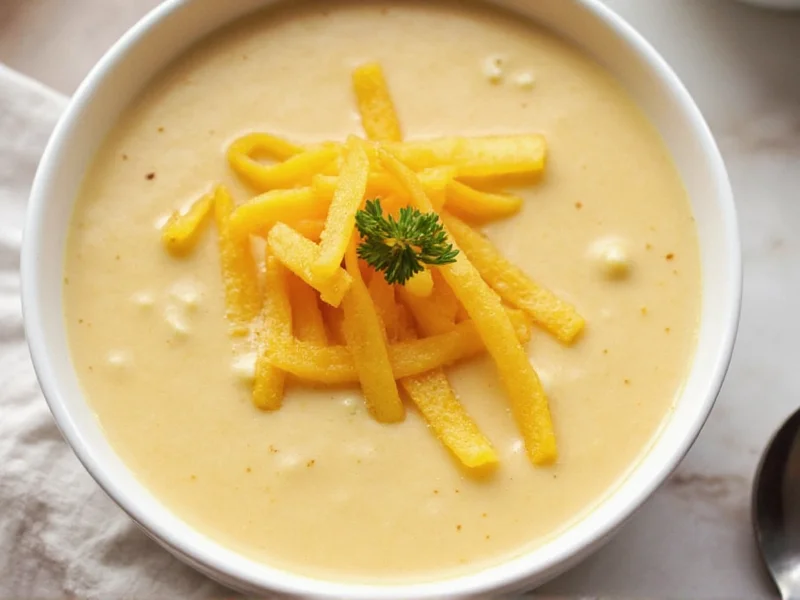When searching for the best potato soup recipes, home cooks want more than just a basic formula—they need reliable methods that guarantee creamy texture without graininess, balanced seasoning, and customizable options for different dietary needs. After testing dozens of variations, we've identified the essential elements that separate good potato soup from truly exceptional versions.
What Makes a Potato Soup Recipe Truly the Best
The best homemade potato soup recipes share several critical characteristics that ensure consistent results. First, potato selection matters significantly—Yukon Gold varieties provide natural creaminess without requiring excessive dairy. Second, proper technique for cooking potatoes prevents them from becoming waterlogged or disintegrating. Third, building flavor layers through sautéed aromatics creates depth that simple boiled potatoes can't match.
Professional chefs emphasize the importance of broth quality in potato soup recipes. A rich, well-seasoned broth forms the foundation, while dairy elements should be added at the right temperature to prevent curdling. The best easy potato soup recipes also include acid balance—often from a splash of white wine vinegar or lemon juice—to cut through the richness.
Top 5 Potato Soup Variations Worth Trying
| Variation Type | Key Ingredients | Prep Time | Special Technique |
|---|---|---|---|
| Classic Creamy | Yukon Golds, leeks, chicken broth, heavy cream | 45 minutes | Partially blend for ideal texture |
| Loaded Baked Potato | Russets, bacon, cheddar, sour cream, chives | 60 minutes | Add toppings after serving |
| Dairy-Free | Yukon Golds, vegetable broth, coconut milk | 40 minutes | Cashew cream alternative |
| Chunky Vegetable | Red potatoes, carrots, celery, thyme | 50 minutes | Double-dice for texture contrast |
| Smoked Paprika | Yukon Golds, smoked paprika, garlic, broth | 45 minutes | Bloom spices in oil first |
The Evolution of Potato Soup: Key Historical Milestones
Understanding potato soup's historical development reveals why certain techniques became standard. This evolution directly impacts modern recipe choices:
- 1884: First standardized American potato soup recipe published in Mrs. Lincoln's Boston Cook Book, establishing the mirepoix base technique still used today. [New York Public Library Digital Collections]
- 1930s: Depression-era adaptations emphasized potato density over dairy due to scarcity, creating the "thick and hearty" style now favored in rustic variations. [NYPL Historical Food Records]
- 1950s: Canned soup innovation (led by Campbell's) introduced stabilizers that prevented curdling, directly influencing modern tempering techniques for dairy. [Smithsonian National Museum of American History]
These historical shifts explain why contemporary recipes balance tradition with practical constraints—a crucial consideration for authentic flavor development.
Essential Techniques for Perfect Potato Soup
Mastering the best potato soup from scratch requires understanding several key techniques. For creamy potato soup without gluey texture, cook potatoes in broth rather than water to maximize flavor absorption. The ideal potato-to-broth ratio is 2:1 by volume—too little potato creates a thin soup, while too much makes it stew-like.
When making dairy-based versions, tempering is crucial for smooth results. Never add cold cream directly to boiling soup. Instead, gradually whisk hot broth into the dairy before incorporating it into the main pot. For the best creamy potato soup texture, blend only one-third of the soup using an immersion blender, leaving chunks for satisfying mouthfeel.
For exceptional flavor development in homemade potato soup recipes, professional chefs recommend the "holy trinity" of mirepoix (onions, celery, carrots) sautéed in butter until deeply caramelized. Adding a Parmesan rind during simmering creates umami depth without overpowering the potato flavor—remove before serving.
Avoiding Common Potato Soup Mistakes
Even experienced cooks make critical errors with potato soup recipes. Overcooking remains the most frequent issue—potatoes should be tender but still hold shape when pierced with a fork. Adding dairy too early causes curdling; wait until soup has cooled slightly below boiling point.
Seasoning mistakes plague many potato soup attempts. Potatoes require generous salting, but add salt gradually—underseasoned soup can be fixed, but oversalted cannot. Acid balance is equally important; finish with lemon juice or vinegar to brighten rich flavors. For the best results with potato soup from scratch, always taste and adjust seasoning at the end of cooking.
Contextual Application Guide: Variation Limitations
Each potato soup variation has specific use cases and constraints. Selecting the right style for your context prevents culinary disappointment:
- Classic Creamy: Ideal for formal dinners but fails with lactose-intolerant guests. Requires fresh dairy—not suitable for long storage without texture degradation.
- Loaded Baked Potato: Perfect for casual gatherings but nutritionally unbalanced for regular consumption (high saturated fat). The bacon element makes it unsuitable for kosher/halal diets without major modifications.
- Dairy-Free: Essential for vegan diets, yet coconut milk versions clash with traditional flavor expectations. Cashew cream requires 4+ hours of soaking—impractical for last-minute meals.
- Smoked Paprika: Excels in autumn menus but overwhelms delicate palates (unsuitable for children's meals). The smoked element conflicts with seafood pairings.
Recognizing these boundaries ensures your potato soup aligns with dietary needs, cultural contexts, and event formality—critical factors often overlooked in generic recipes.
Storage and Reheating Guidelines
Proper storage ensures your best potato soup recipes maintain quality. Cool soup completely before refrigerating in airtight containers—store for up to 4 days. For longer preservation, freeze portions in freezer bags with soup pressed flat for quick thawing.
When reheating creamy potato soup, use low heat with occasional stirring to prevent separation. Dairy-based versions may require a splash of broth if thickened too much. For optimal texture revival, whisk in a small amount of cream while reheating. Never boil reheated potato soup, as this breaks down the potato structure.











 浙公网安备
33010002000092号
浙公网安备
33010002000092号 浙B2-20120091-4
浙B2-20120091-4